
The average temperatures on the Maltese Islands are ot very wide,
so that there are no really very cold Winters or extremely hot Summers.
The average temperatures for the coldest month are a minimum of 9.2oC
and maximum of 15.2oC. The average teperatures for the hottest
months are a minimum of 21.2oC and maximum of 30.7oC.
Record high values of 43oC are rarely recorded. The sea temperature
follows similar trends.
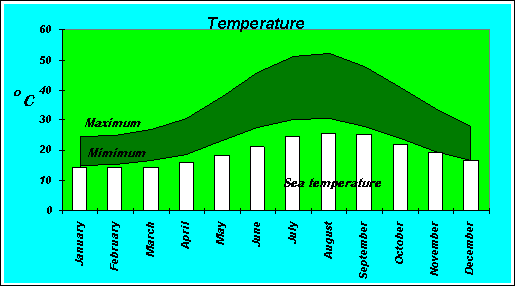
The Islands are situated above the 23.5o latitude of the
Tropic of Cancer, and thus the sun is never directly overhead. At 35.48o
latitude North of the Equator, the length of the days and nights vary according
to the seasons, so that the Summer days are longer than the night, while
the Winter days are shorter.
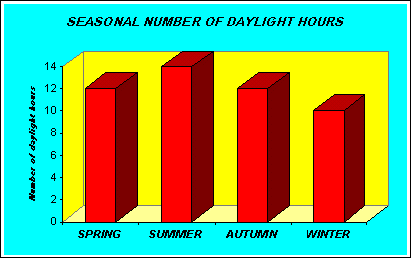
The number of sunshine hours vary from the daylight hours because
of the possibility of of cloud cover. The Maltese Islands have in fact
a fairly large number of days of sunshine, with the maximum number of sunshine
hours amounting to an average of 11.8 hours in July and the shortest amounting
to 5 hours in December. The cloud cover in July is practically nil and
the sunshine hours approximate the daylight hours. In contrast during December
the sunshine hours are about half the daylight hours.
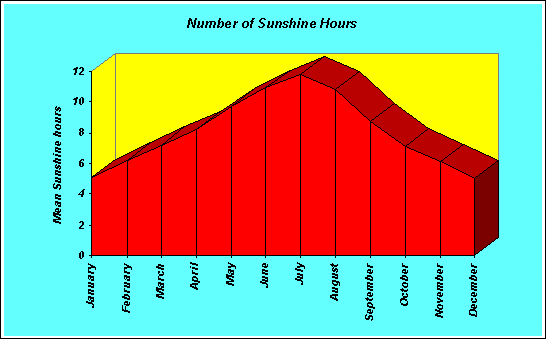
Rainfall in the Maltese Islands is very unpredicatable. Usually the
main body of rain falls in the Winter months, but October storms due to
shallow cyclones coming up from the North African coast or due to convectional
disturbances in the waning stability of the Summer conditions may account
for a significant proportion of yearly rainfall. The average annual rainfall
can be very variable with record high and low of 1031 mm (1859) and 140
mm (1894) respectively. The average total rainfall for 1961-93 was 535.3
mm.
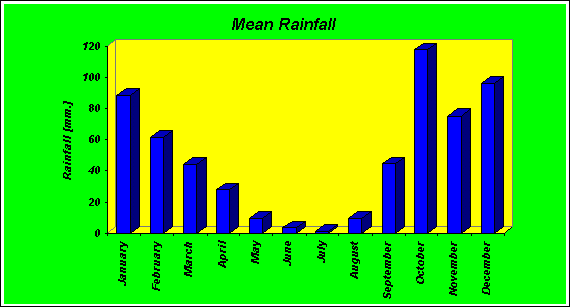
Because of the vicinity of the sea to the land mass the humidity
in the Maltese Islands is constantly high. The average Winter humidity
is 79%, that for Summer 71%. Extremes of 99% (13/02/1958) and 28% (14/08/1957)
have been recorded. The Islands have in general a higher humidity than
neighbouring Mediterranean coastlines since the Islands are more exposes
to the influence of the sea and moist winds.
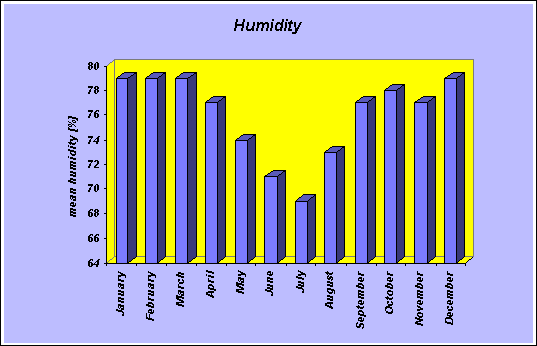
The Maltese Islands are definitely windy, with only 7.7% of the days
of an average year being calm. The wind spead varies between 1.8 to 39
km/hr (1-21 knots). The most common wind in all seasons is the cool North-Westerly
wind known as Majjistral which blows for an average 19% of the days
of the year. Next in importance is the dry North Easterly wind (Grigal)
which blows on 10% of the days particularly in March and September. This
blows with great force and stirs the sea into violent storms. The coldest
wind is the North wind (Tramuntana or Rih Fuq) which blows for about
12% of the days usually in winter. Southern winds are generally unpleasant
bringing humid and hot air, sometimes dust-ladened (South - Rih Isfel,
South-east - Xlokk, South-west - Lbic).

The climate of the Maltese Islands has been affected by the overal global climate changes that have occurred throughout the millennia. The global average temperature since the end of the Ice Age circa 10000 years ago has varied around the present mean, but has shown three definite "Little Ice Ages" where the global average temperature dropped by about 1oC from the present mean. While the differences in global average temperatures during these periods were relatively small, particularly in comparison to the Ice Ages of the Pleistocene, the periods served to mark important pointsin human history even in the Maltese Islands. The first Little Ice Age reached a minimum global temperature at about 6000 BC, the second at about 2000 BC and the third Little Ice Age in the 16th-18th centuries.
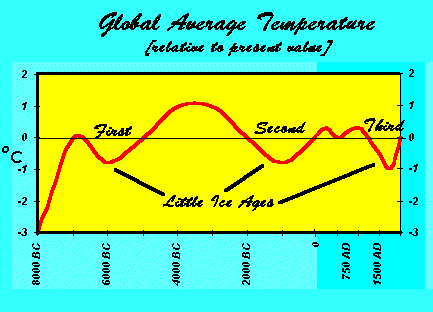
The first Little Ice Age starting at about 7000 BC and lasting about 2000 years corresponded with the gradual spread of a neolithic culture from the eastern lands towards the western Mediterranean. In Malta the advent of Neolithic man to the Islands has been dated at about 7000 BC. This Neolithic cultural migration may have been initiated from the east by changes in climate in the countries of origin. On the basis of an analysis of modern climatic data, such a cold peak would have caused a dry spell in western Asia and southern Europe. This resulting southern dry spell may have caused a series of droughts that forced population migration.
The effects resulting from the southern dry spells caused by a all in global temperatures were more evident wth the second Little Ice Age, which occurred around 2000 BC. The resulting dry spell has been suggested to have been the cause for the collapse of several circum-Mediterranean civilisations. Evidence for the occurrence of the second Little Ice Age has been obtained from the ocean sediments collected from Greenland and Iceland, which show the occurrence of a cold pead around 2200 BC. The climatic change appears, on the evidence obtained from the cores of dusts sediment on the floor of the Gulf of Oman, to have occurred abruptly, possibly following a volcanic eruption.
The third millenium BC saw a general decline in the growth and efflorescence of societies in the Aegean, Egypt, the Indus Valley and western Asia. In Egypt, the Old Kingdom, during which the great pyramids were built, gave way to the turmoil of the First Intermediate Period; in Palestine, Early Bronze Age towns were abandoned; in Mesapotania, the Akkadin Empire collapsed c.2200 BC and nomadic peoples made strange ovements across and down the Euphrates and Tigris valleys; Cretan and Greek civilisations collapsed in 2200 BC; the great cities in the Indus Valley collapsed between 2200 and 2100 BC. The collapse of these societies often left an archaeological hiatus of about 300 years. A similar civilisation collapse occurred in the Maltese Islands. The Tarxien Temple phase period of the Maltese Islands apparently disappeared somewhat suddenly and mysteriously at about 2500 BC, leaving a cultural hiatus of several scores of years after which the Islands were repopulated by an entirely different people carrying a totally different culture. Archaeological evidence from the Tarxien excavations had suggested that the hiatus was characterised by a dry environment, and the abandonment of the Islands by the Temple people was probably caused by the draught resulting from the second Little Ice Age.
The third Little Ice Age during the 16th-18th centuries AD has also been corrlated with significant environmental changes which affected the development of western human civilisation.